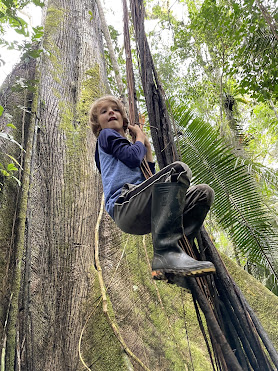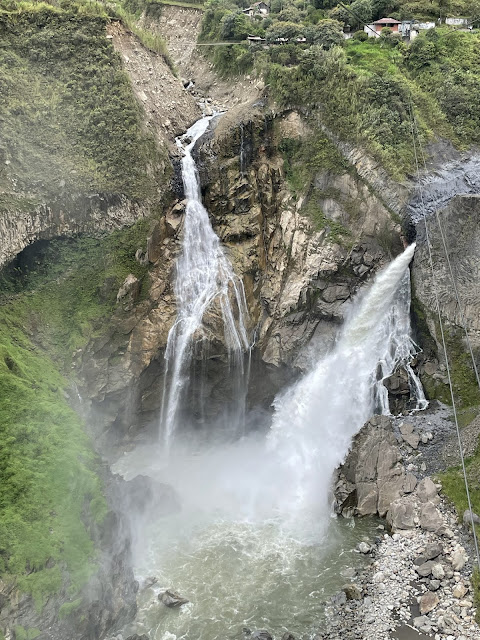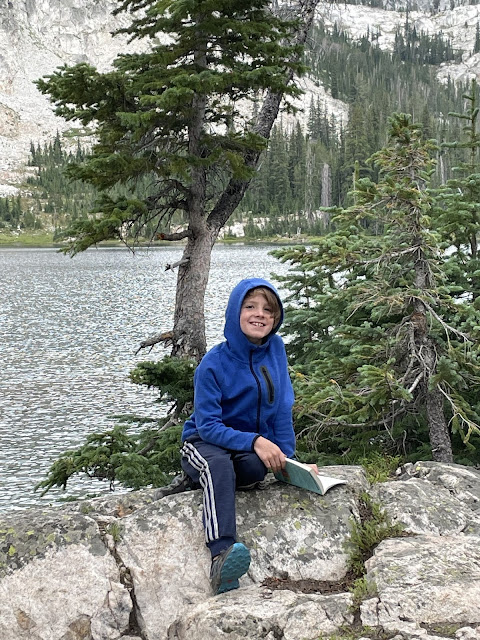An Interview with Locke
An Interview with Locke
 |
| Swinging from the Ceiba lines |
Nick: “You have traveled 5,765 miles from Anchorage plus many more to see the world. What was your favorite section of traveling and why?”
Locke: “I liked Baños because of: waterfalls, zip line cart, spider in the bathroom, bikes, bike ride to the waterfalls, hiking, swing at the edge of the world, the fishing pond, the truck. They made me happy. It was a huge waterfall. The swing at the end of the world was big, long, hot, and you got to swing above a volcano.”
 |
| Baños waterfall |
 |
| Pailón del Diablo |
 |
| Swing over Tungurahua |
 |
| Biking the Ruta de las Cascadas |
Nick: “Here are the places you have visited in the past 2 months: Missoula, Trout Creek MT, Stanley ID (hot springs/backpacking), Craters of the Moon National Monument, Park City UT, Dinosaur National Park, Vail CO, Steamboat Springs CO, Denver CO (Water World, Elitches), Miami FL, Gyuaquil EC, Cuenca (moving in, zoo, climbing gym, hot pools), Lago Agrio (reserve with jungle animals), Cuyabeno Reserve (via canoe to Nicky Jungle Lodge), Tena (rafting), and Baños (waterfall valley and the swing off the end of the world). Describe for us three amazing things that you saw while traveling to these places and 3 things that you learned along the way.”
 |
| Dinosaur national park |
 |
| Loving Nana in Vail |
 |
| Alice Lake, ID Locke is never without a good book in his hands! |
 |
| Mah Jongg! A new family obsession :) |
 |
| Elitch Gardens, Denver We're not at the Alaska State Fair anymore! |
Locke: “The first amazing new thing I saw were the waterfalls at the end of a fun bike ride in Baños. The second thing I saw was the pink river dolphins because they were hunting and I liked the way they almost leaped out of the water. The third thing I saw was the monkeys because of how they swing and jump and move. The first thing I learned was that no matter how hard it is, if you don’t try, it is guaranteed that you won’t get it. The second thing I learned was that if you don’t look you’ll never find it. The third thing I learned was how to make yucca bread:
 |
| First, you pull the yucca out of the ground. |
 |
| Second, you skin the yucca. |
 |
| Third, you grind the yucca. |
 |
| Then you wring out all the water. |
 |
| Last, you spread out the flour in a circle and cook it over a fire.” |
Nick: “You spent a lot of time and effort organizing the animals that we saw in the jungle. Can you share your outline with us and will you describe your favorite animal of the ones we saw? Please describe the animal, tell us its diet, list its predators, describe its habitat, and give us some wow facts.”
Locke: “My favorite animal is the monkey. I don’t have a favorite monkey. A monkey’s predators are ocelots, jaguars, pumas, eagles, snakes, and bush dogs. Its habitat is in the trees. Its diet is fruit. Its wow facts are that they can jump up to 20 feet and they can hang from their tails (this is called a prehensile tail) and they dance around fires.”
Locke’s Taxonomy List of Animals seen in Cuyabeno
1. Fish
a. Big fish
b. Small fish
2. Mammals
A.) Monkeys
1. Black tamarind
2. yellow handed titi
3. pygmy marmoset (pocket monkey)
4. red howler
5. squirrel monkey
6. Miller’s Saki
7. Wooly monkey
8. Night noisy monkey
9. Capuche monkey
B.) Water mammals
1. Pink River Dolphins
C.) Kinkajou
D.) Bats
1. Long-nosed bats
2.fishing bats
E.) Sloths
1. Two toed sloth
3. Bugs
A. Spiders
1. fishing spider
2. yellow bull spider
3. bridge spider
4. tarantula
5. scorpian spider
6. Hunting spiders:
a. hunting spider
b. white hunting spider
7. social spider
8. silk weaver spider
9. orb spider
10. housman spider
B. Insects:
1. Flying insects
a. Butterflies:
i. Morpheo butterfly
ii. see-through butterfly
iii. swallow-tail butterfly
iv. night butterfly
b. Beatles
i. dung beatle
ii. longhorn beetle
iii. cocoa beetle
c. dragonfly
d. Othoptera
i. crickets
I. green cricket
II. cone-faced cricket
ii. grasshopper
iii. katydid
e. Cockroach
f. wasps
g. firefly
h. lady bug
2. Non-flying insects
a. Stickbugs
i. jumping stickbug
ii. stickbug
b. Millipeds
i. armored milliped
ii. milliped
c. Ants
i. fire ants
ii. leaf cutter ants
iii. normal ants
iv. acid (lime) ants
d. Termites
e. Caterpillars
i. big white caterpillar
ii. dangerous fuzzy caterpillar
iii. orange capped caterpillar
iv. fast and pokey yellow caterpillar
v. fuzzy other caterpillar
4. Birds:
a. macacws
i. red bellied macaw
ii. blue and yellow macaw
iii. chestnut (trumpet) macaw
b. black caracara
c. herons
i. night heron`
ii. tiger heron
iii. strident heron
d. parrots
ii. blue headed parrot
iii. orange cheeked parrot
iv. orange winged amazon parrot
v. mealy parrot
e. little coocoo
f. southern lapwing swift
g. anis
i. smooth billed ani
ii. greater ani (boiling water bird)
h. vultures
i. yellow headed vulture
ii. black vulture
i. kingfishers
i. ringed kingfisher
ii. amazon kingfisher
iii. kingfisher
j. ducks
i. sungripe duck
ii. moscovi duck
k. swallow tail kite
l. toucans
i. white throated toucan
ii. many banded toucan
m. casiques
i. casique
ii. yellow rumped casique
n. oropendolas
i. oropendola
ii. crested oro pendula
o. huatzin (stinky turkey)
p. parakeets
i. maroon tailed parakeet
ii. cobalt winged parakeet
q. fly catcher
r. black fronted manebird
s. hawks
i. slate colored hawk
ii. roadside hawk
t. laughing falcon
u. violatious jay
v. trogons
i. black tailed trogon
ii. amazonian violatious trogon
w. ruddy pidgeon
x. tropical cormorant
y. yellow tufted woodpecker
z. lettered aracari
aa. red capped cardinal
5. reptiles
a. caimans
i. baby black caiman
ii. spectacled caiman
b. snakes
i. boas
l. tree boa
ll. anaconda
ii. black headed calice snake- morete snake
iii. green striped vine snake
iv. blunt headed tree snake
c. lizards
i. amazon dragon lizard
ii. common forest anole
iii. common house gecko
6. Amphibians
a. frogs
i. flat headed granilian tree frog
ii. sharp nosed frog
iii. common rain frog
iv. crested forest toad
v. smokey jungle frog
b. amazonian salamander
7. Soft Body
a. snails
i. small snail
ii. big snail
b. land planoreal (leech)
c. zombie fungus



Locke, your taxonomy list is incredible! I hope you keep it up. Is zombie fungus a real thing??
ReplyDelete